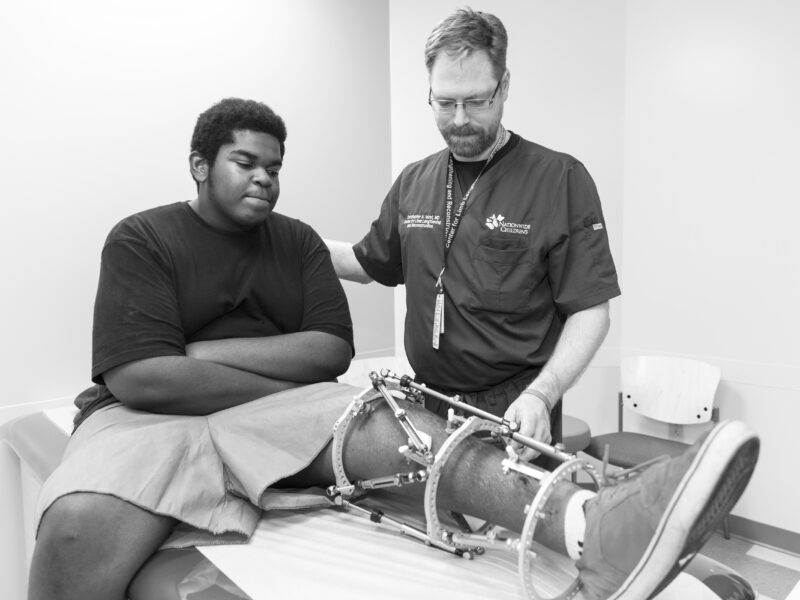Regional Anesthesia Dramatically Reduces Opioid Use After Limb Lengthening and Reconstructive Surgeries
Regional Anesthesia Dramatically Reduces Opioid Use After Limb Lengthening and Reconstructive Surgeries https://pediatricsnationwide.org/wp-content/uploads/2020/01/011218ds0851_web-1024x584.jpg 1024 584 Katie Brind'Amour, PhD, MS, CHES Katie Brind'Amour, PhD, MS, CHES https://pediatricsnationwide.org/wp-content/uploads/2021/03/Katie-B-portrait.gif- January 29, 2020
- Katie Brind'Amour, PhD, MS, CHES

The peripheral catheter approach to postoperative pain management may also shorten length of stay.
When clinicians in the Department of Anesthesiology and Pain Medicine at Nationwide Children’s Hospital first proposed the use of regional anesthesia for the patients of Christopher Iobst, MD, he was resistant to the idea. As an orthopedic surgeon specializing in limb lengthening and reconstruction, he worried that patients with a numb leg would not only be unable to begin their early postoperative physical therapy — an essential part of their clinical management — but that they would also be unable to tell whether something had gone wrong with the surgery.
“I didn’t want to risk missing a rare but catastrophic event, such as compartment syndrome or nerve damage,” says Dr. Iobst. “But the regional anesthesia team here is extremely talented, and worked with me to develop a protocol to keep patients both comfortable and safe.”
The anesthetists developed a unique, dilute solution for use in peripheral nerve catheters. At the end of the limb surgery, anesthetists inserted the catheters at points specific to the location of the expected pain. In the recovery room immediately afterward, leg function and health were assessed as soon as patients were alert enough to answer questions and move their limbs. If all was well, the diluted pain medication would then be administered — first with a bolus (0.2% ropivacaine at 0.1 mL/kg ideal body weight) and then at a slow, steady dose (0.1% ropivacaine at 0.1 mL/kg/hour). Tibial limb lengthening patients with two catheters had the medicine delivered at half-volume through each catheter to equal the same total dose.
“They titrate it to the perfect spot, where patients still have function but no pain,” says Dr. Iobst. The research team retrospectively reviewed the postoperative pain scores, opioid use and length of stay for 70 consecutive osteotomy patients (median age 14.5), 41 of whom had received regional anesthesia postoperatively.
In the first 48 hours after anesthesia, patients who had received regional anesthesia required 2-5 times fewer opioids than those managed without it (compared as oral morphine equivalents), depending on surgery type. The groups had no significant difference in their reported pain levels — indicating regional anesthesia was as good as opioids for pain control — and regional anesthesia patients had an average inpatient stay 30-40% shorter than those managed without regional anesthesia (length of stay differences only achieved significance among the femoral lengthening subgroup).
Peripheral nerve catheters deliver the pain medication via a portable machine that patients can take home with them. Five days after the surgery, when the acute pain of the operation has typically subsided, patients remove the catheter and can continue with over-the-counter pain management alone, such as oral acetaminophen. In contrast, non-regional anesthesia patients must first be gradually weaned from intravenous pain control onto oral medication, which can take several days.
“It’s a wonderful thing, and I’ve completely converted my viewpoint. From my perspective, I can feel satisfied that I won’t miss a catastrophic postoperative complication, my patients can immediately go to physical therapy and do all the things they need to without their legs feeling asleep, and they are so comfortable that they don’t go home on high doses of oral pain medication,” says Dr. Iobst. “It’s like a fantasy.”
Dr. Iobst recently presented the data from this project at the annual scientific meeting for the Limb Lengthening and Reconstruction Society, where the presentation won the award for Best Clinical Research. A paper on the research has since been submitted for publication. The study team has also initiated longer-term follow-up of patients with regional anesthesia to determine if the equivalent pain control and reduction in opioid use is maintained throughout the first several months after discharge.
Reference:
Arce Villalobos M, Veneziano G, Iobst C, Miller R, Walch AG, Roth C, Argote-Romero G, Martin DP, Beltran RJ, Tobias JD. “Dilute peripheral nerve catheters: A unique method to decrease postoperative narcotic usage in limb reconstruction patients.” Presentation at the Limb Lengthening and Reconstruction Society 28th Annual Scientific Meeting; Jun 2019. Boston, MA.
Arce Villalobos M, Veneziano G, Iobst C, Miller R, Walch AG, Roth C, Argote-Romero G, Martin DP, Beltran RJ, Tobias JD. Regional Anesthesia for Pain Management After Orthopedic Procedures for Treatment of Lower Extremity Length Discrepancy. Journal of Pain Research. 2020;13:547-552
Photo credit: Nationwide Children’s
About the author
Katherine (Katie) Brind’Amour is a freelance medical and health science writer based in Pennsylvania. She has written about nearly every therapeutic area for patients, doctors and the general public. Dr. Brind’Amour specializes in health literacy and patient education. She completed her BS and MS degrees in Biology at Arizona State University and her PhD in Health Services Management and Policy at The Ohio State University. She is a Certified Health Education Specialist and is interested in health promotion via health programs and the communication of medical information.
-
Katie Brind'Amour, PhD, MS, CHEShttps://pediatricsnationwide.org/author/katie-brindamour-phd-ms-ches/April 27, 2014
-
Katie Brind'Amour, PhD, MS, CHEShttps://pediatricsnationwide.org/author/katie-brindamour-phd-ms-ches/April 27, 2014
-
Katie Brind'Amour, PhD, MS, CHEShttps://pediatricsnationwide.org/author/katie-brindamour-phd-ms-ches/April 27, 2014
-
Katie Brind'Amour, PhD, MS, CHEShttps://pediatricsnationwide.org/author/katie-brindamour-phd-ms-ches/April 28, 2014
- Post Tags:
- Anesthesiology
- Orthopedics
- Posted In:
- In Brief







